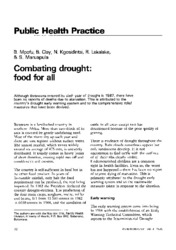| dc.contributor.author | Mpofu, B. | |
| dc.contributor.author | Kgosidintsi, N. | |
| dc.contributor.author | Lekalake, R. | |
| dc.contributor.author | Maruapula, S. | |
| dc.date.accessioned | 2022-07-12T10:05:46Z | |
| dc.date.available | 2022-07-12T10:05:46Z | |
| dc.date.issued | 1988 | |
| dc.identifier.citation | Mpofu, B., Clay, B., Kgosidintsi, N., Lekalake, R., & Maruapula, S. (1988). Combating drought: food for all. In World health forum 1988; 9 (1): 92-97. | en_US |
| dc.identifier.issn | 0251-2432 | |
| dc.identifier.uri | http://www.who.int/bulletin/en/ | |
| dc.identifier.uri | https://hdl.handle.net/13049/503 | |
| dc.description | CC BY 3.0 | en_US |
| dc.description.abstract | Although Botswana entered its sixth year of drought in 1987, there have been no reports of deaths due to starvation. This is attributed to the country's early warning system and to the comprehensive relief measures that have been devised.Although Botswana entered its 6th year of drought in 1987, there have been no reports of deaths due to starvation. This is attributed to the country's drought early warning system and to the comprehensive relief measures that have been devised. This article discusses how various government agencies work together to make the early warning system work. Botswana relies greatly on the National Nutrition Surveillance System to monitor the effects of drought on the human population. The data it provides can be linked to information on food aid distribution supplied by the Food Resources Department. This is possible since most of the supplementary feeding programs are carried out at health facilities, and the foodstuffs are supplied according to the number of beneficiaries reporting. The food needs for direct feeding of malnourished children are determined by the numbers recorded in the surveillance system. Close monitoring is necessary in order that adjustments can be made in accordance with the fluctuations that occur. It is intended that malnourished children will continue to receive special attention and that improved services will meet the needs of healthy children in the years ahead, whatever trends develop in the drought situation. | en_US |
| dc.language.iso | en | en_US |
| dc.publisher | World Health Organization | en_US |
| dc.relation.ispartofseries | World health forum 1988;9 (1): 92-97 | |
| dc.subject | Botswana | en_US |
| dc.subject | Preschool | en_US |
| dc.subject | Child | en_US |
| dc.subject | Desert Climate | en_US |
| dc.subject | Disasters | en_US |
| dc.subject | Food Service | en_US |
| dc.subject | Human | en_US |
| dc.subject | Infant | en_US |
| dc.subject | Newborn | en_US |
| dc.subject | Nutritional Status | en_US |
| dc.subject | Relief work | en_US |
| dc.subject | Starvation | en_US |
| dc.title | Combating drought: food for all. | en_US |
| dc.type | Article | en_US |

